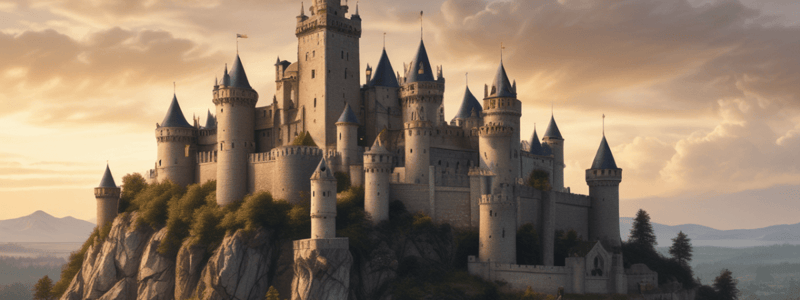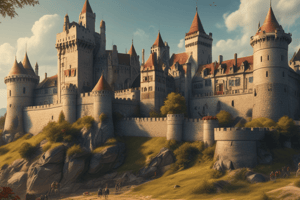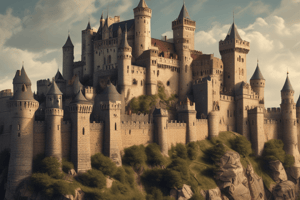Podcast
Questions and Answers
What was the primary purpose of building castles?
What was the primary purpose of building castles?
- To attract visitors
- To assert aristocratic authority (correct)
- To provide shelter for peasants
- To showcase architectural prowess
What material did builders start using for greater security?
What material did builders start using for greater security?
- Wood
- Steel
- Masonry (correct)
- Concrete
What type of weapon was not effective against castle walls?
What type of weapon was not effective against castle walls?
- Swords (correct)
- Bows and arrows
- Cannons
- Trebuchets
What heavy artillery was developed to try to break down castle walls?
What heavy artillery was developed to try to break down castle walls?
What was often involved in castle sieges?
What was often involved in castle sieges?
What happened if defenders failed to honor a negotiated surrender?
What happened if defenders failed to honor a negotiated surrender?
What is Carcassonne in France considered to be?
What is Carcassonne in France considered to be?
What made Caerphilly Castle in Wales unique?
What made Caerphilly Castle in Wales unique?
What was Harlech Castle built for?
What was Harlech Castle built for?
Who held court at Harlech Castle and drew up a vision of an independent Wales?
Who held court at Harlech Castle and drew up a vision of an independent Wales?
What role did castles play in the English Civil War?
What role did castles play in the English Civil War?
How did Raglan Castle fall to the parliamentary army in 1646?
How did Raglan Castle fall to the parliamentary army in 1646?
Flashcards are hidden until you start studying
Study Notes
- Castles are world heritage sites that draw millions of visitors to Europe.
- They were built primarily for defense and to assert aristocratic authority.
- Castles made of wood were vulnerable, so builders began using masonry for greater security.
- Swords and other individual weapons were not effective against castle walls.
- Heavy artillery such as trebuchets were developed to try to break down castle walls.
- Castle sieges could be long and brutal, often involving starvation and a war of attrition.
- Negotiations and rules of engagement were observed as a matter of honor.
- If the defenders failed to honor a negotiated surrender, they gave up their right to safe passage.
- The siege of Rochester Castle in 1215 was one of the bloodiest in English history.
- Rochester Castle was built by William of Corbeil, an expert in building robust structures.
- Castle building technology evolved over time with improvements such as round towers, moats, and drawbridges.
- Castles could be conquered and change hands from one side to another multiple times.
- The search for the perfect castle, one that could not be taken, began in Europe.
- Carcassonne in France is considered one of the greatest fortresses in Christendom and has a concentric design with two outer walls, 53 towers, and barbicans.
- Carcassonne's defensive system is a thousand fine details, including irregular embossed walls, wooden shelters, and murder holes.
- The count's castle is at the center of Carcassonne's fortified town and is the seat of feudal power.
- The Black Prince, a gifted military leader, campaigned as far as Carcassonne's outer walls during the century-long struggle for control of France.
- The restoration of Carcassonne by the 19th-century architect Violet le Duc allows us to appreciate this medieval masterpiece.
- Gilbert Declare took defensive strategy to a whole new level with the design of Caerphilly Castle in Wales, which had walls within walls and multiple layers of defense.
- Castles were highly potent symbols of revolt when they fell into the hands of conquered people.
- Harlech Castle was built by English King Edward I to crush Welsh resistance.
- In 1400, the Welsh rebelled under leader Owain Glendur and slowly recaptured most of Wales, making Harlech their most important seat.
- Glendur held court at Harlech and drew up a vision of an independent Wales.
- The English fought back, and Harlech was besieged and taken with the use of cannons in 1408.
- In the 1460s, the Wars of the Roses saw rival factions fighting for the English crown, with Harlech becoming a major Lancastrian stronghold.
- The Tudor family made Harlech their center of operations and eventually seized the English crown from the House of York.
- The English Civil War saw castles play a role in warfare again, with Raglan Castle being one of the last outposts of royal resistance.
- Raglan Castle fell to the parliamentary army in 1646, with the use of artillery.
- The fall of Raglan Castle marked the end of the first phase of the English Civil War.
- The castle continued to be used as a fortress during the summer of 1648 when royalist supporters took up arms again.
Studying That Suits You
Use AI to generate personalized quizzes and flashcards to suit your learning preferences.




